seats Acura Integra 2000 Hatchback User Guide
[x] Cancel search | Manufacturer: ACURA, Model Year: 2000, Model line: Integra, Model: Acura Integra 2000Pages: 279, PDF Size: 3.57 MB
Page 30 of 279
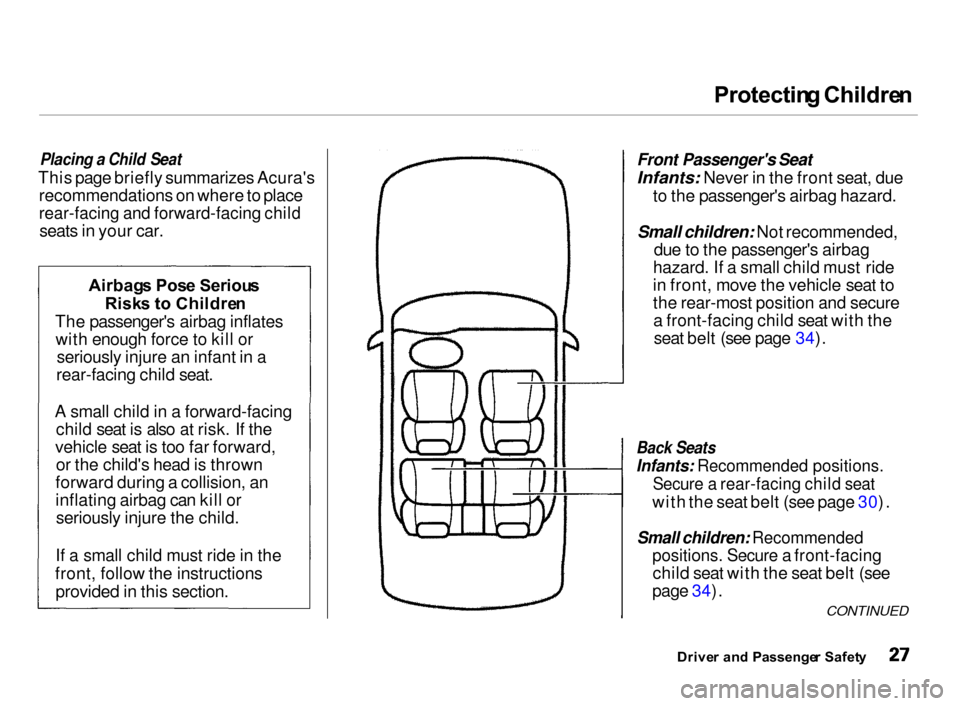
Protectin
g Childre n
Placing a Child Seat
This page briefly summarizes Acura's recommendations on where to place
rear-facing and forward-facing child
seats in your car.
Front Passenger's Seat
Infants: Never in the front seat, due
to the passenger's airbag hazard.
Small children: Not recommended,
due to the passenger's airbag
hazard. If a small child must ride
in front, move the vehicle seat to
the rear-most position and secure a front-facing child seat with theseat belt (see page 34).
Back Seats
Infants: Recommended positions.
Secure a rear-facing child seat
with the seat belt (see page 30).
Small children: Recommended
positions. Secure a front-facing
child seat with the seat belt (see
page 34).
Drive r an d Passenge r Safet y
Airbag
s Pos e Seriou s
Risk s t o Childre n
The passenger's airbag inflates with enough force to kill or seriously injure an infant in a
rear-facing child seat.
A small child in a forward-facing child seat is also at risk. If the
vehicle seat is too far forward, or the child's head is thrown
forward during a collision, an
inflating airbag can kill or seriously injure the child.
If a small child must ride in the
front, follow the instructions provided in this section.
CONTINUED
Page 31 of 279
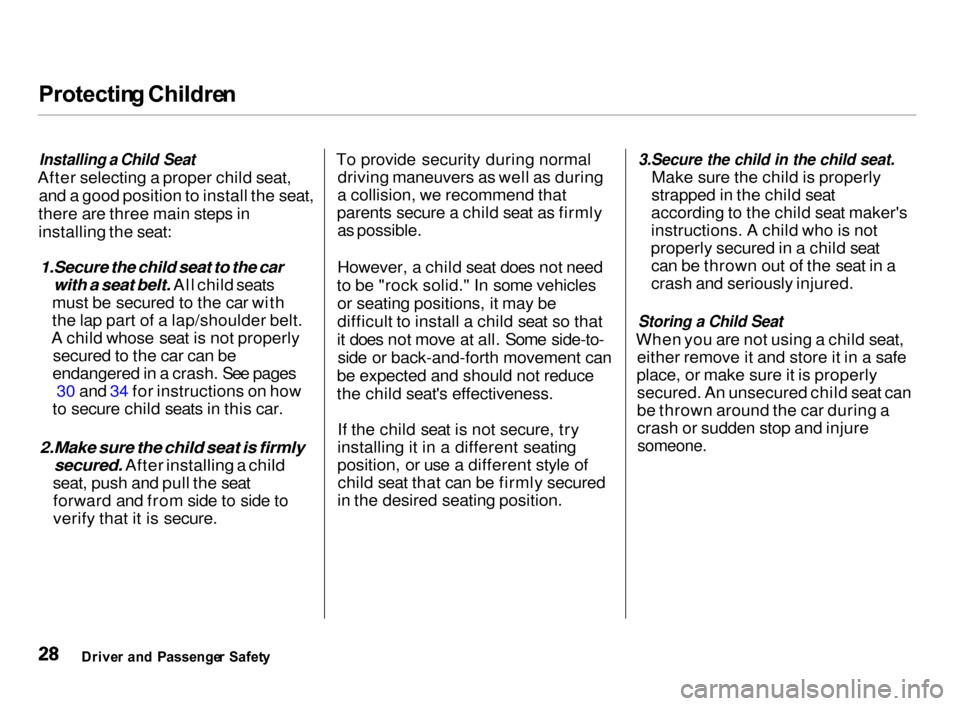
Protectin
g Childre n
Installing a Child Seat
After selecting a proper child seat, and a good position to install the seat,
there are three main steps in
installing the seat:
1.Secure the child seat to the car
with a seat belt. All child seats
must be secured to the car with
the lap part of a lap/shoulder belt.
A child whose seat is not properly secured to the car can be
endangered in a crash. See pages 30 and 34 for instructions on how
to secure child seats in this car.
2.Make sure the child seat is firmly
secured. After installing a child
seat, push and pull the seat forward and from side to side to
verify that it is secure.
To provide security during normal
driving maneuvers as well as during
a collision, we recommend that
parents secure a child seat as firmly as possible.
However, a child seat does not need
to be "rock solid." In some vehicles or seating positions, it may be
difficult to install a child seat so that
it does not move at all. Some side-to- side or back-and-forth movement can
be expected and should not reduce
the child seat's effectiveness.
If the child seat is not secure, try
installing it in a different seating
position, or use a different style of child seat that can be firmly secured
in the desired seating position.
3.Secure the child in the child seat.
Make sure the child is properly
strapped in the child seat
according to the child seat maker's
instructions. A child who is not
properly secured in a child seat can be thrown out of the seat in a
crash and seriously injured.
Storing a Child Seat
When you are not using a child seat, either remove it and store it in a safe
place, or make sure it is properly secured. An unsecured child seat can
be thrown around the car during a
crash or sudden stop and injure
someone.
Drive r an d Passenge r Safet y
Page 32 of 279

Protectin
g Childre n
Protectin g Infant s
Child Seat Type
Only a rear-facing child seat provides
proper support for a baby's head, neck, and back. Infants up to aboutone year of age must be restrained in
a rear-facing child seat.
Two types of seats may be used: a seat designed exclusively for infants,
or a convertible seat used in the rear-
facing, reclining mode. We recommend that an infant be
restrained in a rear-facing child seat
until the infant reaches the seat
maker's weight or height limit and is able to sit up without support.
Rear-Facing Child Seat Placement
In this car, a rear-facing child seat
can be placed in any seating position
in the back seat, but not in the front
seat.
Never put a rear-facing child seat in
the front seat. If the passenger's
airbag inflates, it can hit the back of
the child seat with enough force to
kill or seriously injure an infant. If an infant must be closely watched, we
recommend that another adult sit in
the back seat with the baby.
Do not put a rear-facing child seat in
a forward-facing position. If placed
facing forward, an infant could be
very seriously injured during a
frontal collision.
CONTINUED
Drive r an d Passenge r Safet y
Placing a rear-facing child seat
in the front seat can result in
serious injury or death if the
airbags inflate.
Always place a rear-facing child
seat in the back seat, not the
front.
Page 33 of 279
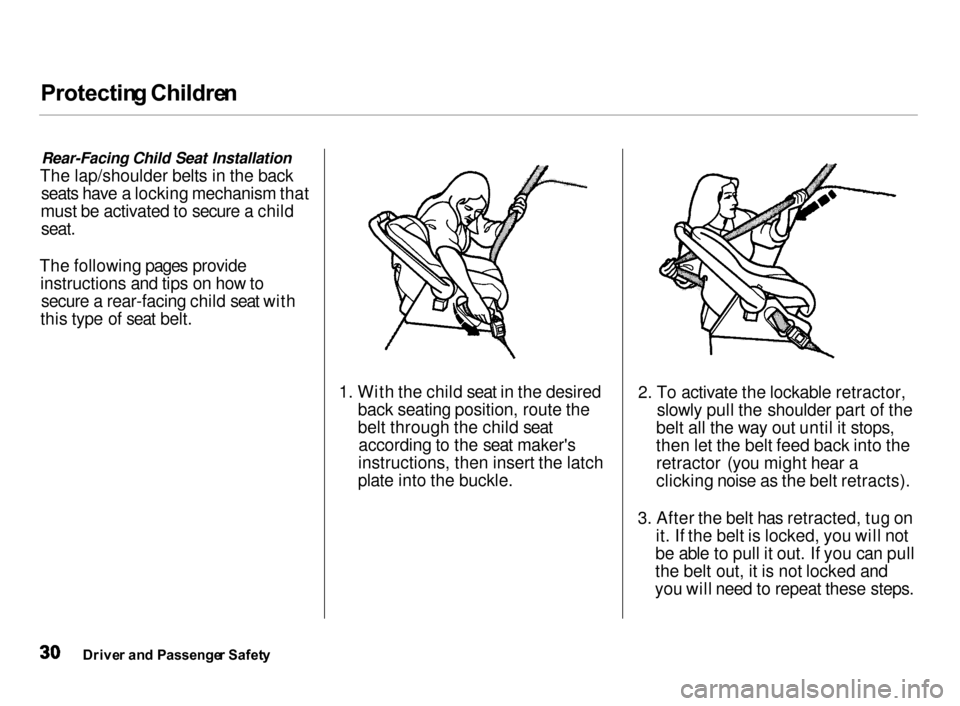
Protectin
g Childre n
Rear-Facing Child Seat Installation
The lap/shoulder belts in the back seats have a locking mechanism that
must be activated to secure a child
seat.
The following pages provide instructions and tips on how tosecure a rear-facing child seat with
this type of seat belt.
1. With the child seat in the desired
back seating position, route the
belt through the child seataccording to the seat maker's
instructions, then insert the latch
plate into the buckle.
2. To activate the lockable retractor,
slowly pull the shoulder part of the
belt all the way out until it stops,
then let the belt feed back into the
retractor (you might hear a
clicking noise as the belt retracts).
3. After the belt has retracted, tug on
it. If the belt is locked, you will not
be able to pull it out. If you can pull
the belt out, it is not locked and
you will need to repeat these steps.
Drive r an d Passenge r Safet y
Page 36 of 279
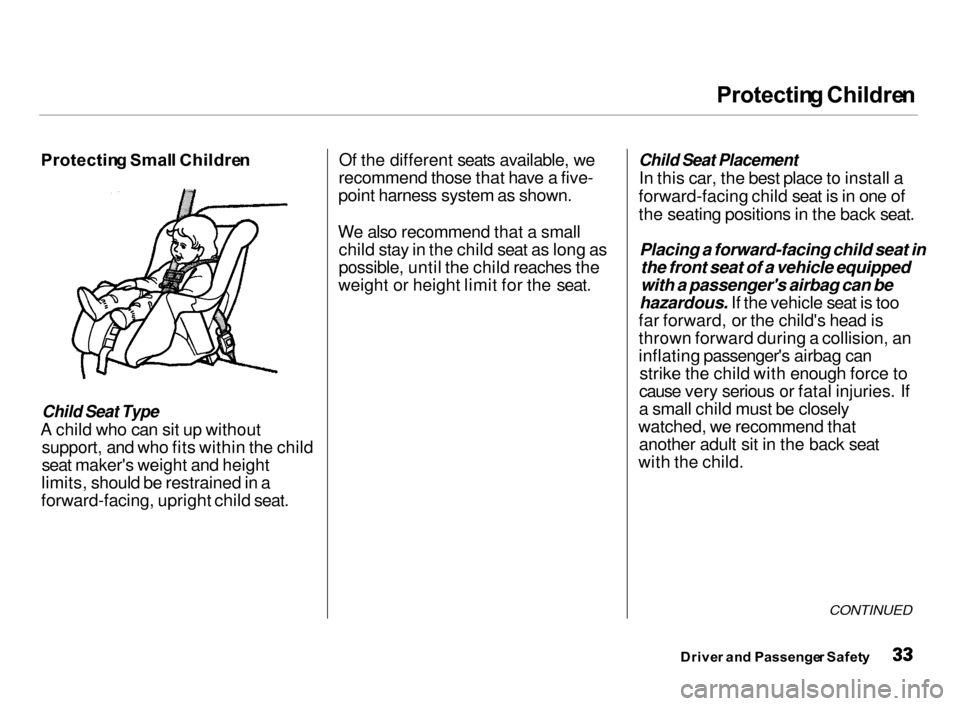
Protectin
g Childre n
Protectin g Smal l Childre n
Child Seat Type
A child who can sit up without support, and who fits within the child
seat maker's weight and height
limits, should be restrained in a
forward-facing, upright child seat. Of the different seats available, we
recommend those that have a five-
point harness system as shown.
We also recommend that a small child stay in the child seat as long as
possible, until the child reaches the
weight or height limit for the seat.
Child Seat Placement
In this car, the best place to install a
forward-facing child seat is in one of
the seating positions in the back seat.
Placing a forward-facing child seat in
the front seat of a vehicle equipped
with a passenger's airbag can be
hazardous. If the vehicle seat is too
far forward, or the child's head is
thrown forward during a collision, an
inflating passenger's airbag can strike the child with enough force to
cause very serious or fatal injuries. If
a small child must be closely
watched, we recommend that another adult sit in the back seat
with the child.
CONTINUED
Drive r an d Passenge r Safet y
Page 40 of 279
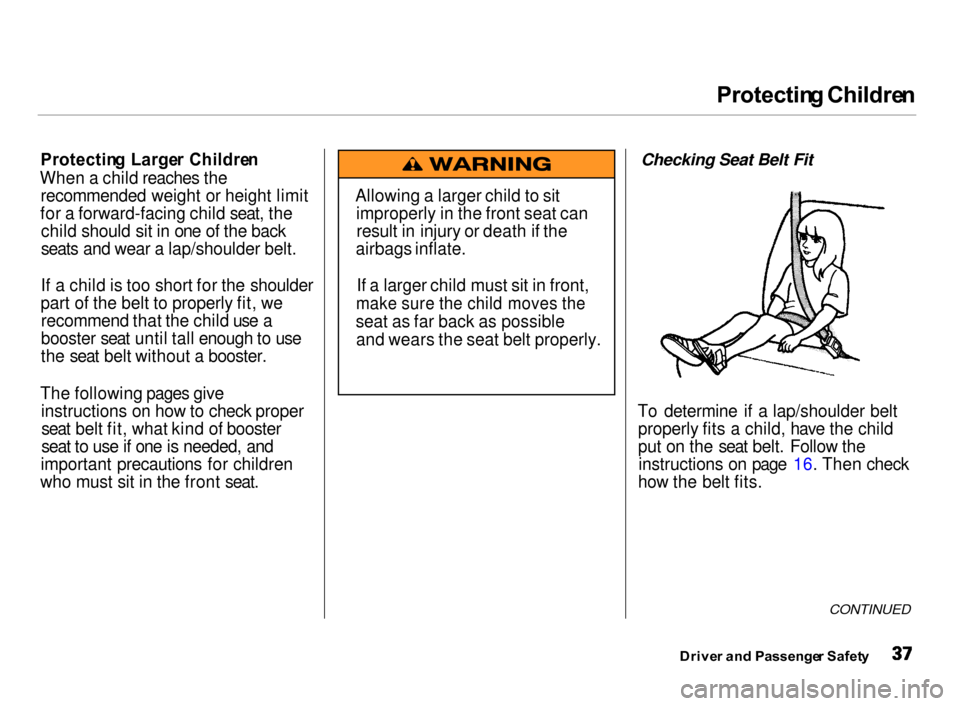
Protectin
g Childre n
Protectin g Large r Childre n
When a child reaches the recommended weight or height limit
for a forward-facing child seat, the child should sit in one of the back
seats and wear a lap/shoulder belt.
If a child is too short for the shoulder
part of the belt to properly fit, we recommend that the child use a
booster seat until tall enough to use
the seat belt without a booster.
The following pages give instructions on how to check properseat belt fit, what kind of booster
seat to use if one is needed, and
important precautions for children
who must sit in the front seat.
Checking Seat Belt Fit
To determine if a lap/shoulder belt properly fits a child, have the child
put on the seat belt. Follow theinstructions on page 16. Then check
how the belt fits.
CONTINUED
Drive r an d Passenge r Safet y
Allowing a larger child to sit
improperly in the front seat canresult in injury or death if the
airbags inflate.
If a larger child must sit in front,
make sure the child moves the
seat as far back as possible and wears the seat belt properly.
Page 43 of 279
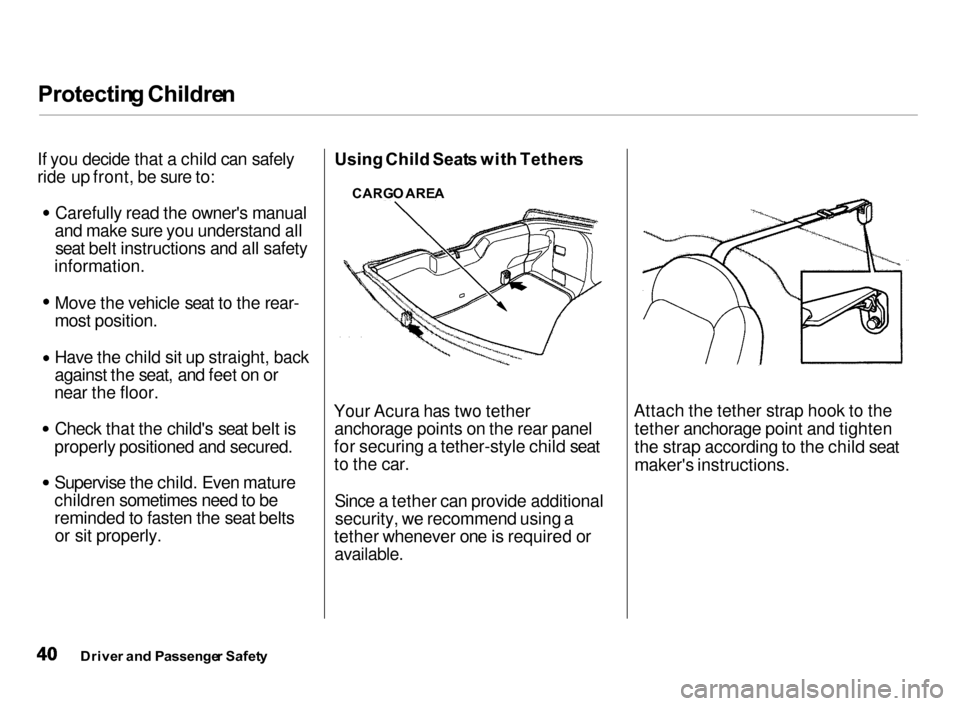
Protectin
g Childre n
If you decide that a child can safely
ride up front, be sure to: Carefully read the owner's manual
and make sure you understand all seat belt instructions and all safety
information.
Move the vehicle seat to the rear-
most position.
Have the child sit up straight, back
against the seat, and feet on or
near the floor. Check that the child's seat belt is
properly positioned and secured. Supervise the child. Even mature
children sometimes need to be
reminded to fasten the seat belts
or sit properly. Using
Child Seats wit h Tether s
Your Acura has two tether anchorage points on the rear panel
for securing a tether-style child seat
to the car.
Since a tether can provide additionalsecurity, we recommend using a
tether whenever one is required or
available.
Attach the tether strap hook to the
tether anchorage point and tighten
the strap according to the child seat
maker's instructions.
Drive r an d Passenge r Safet y
CARG
O ARE A
Page 46 of 279
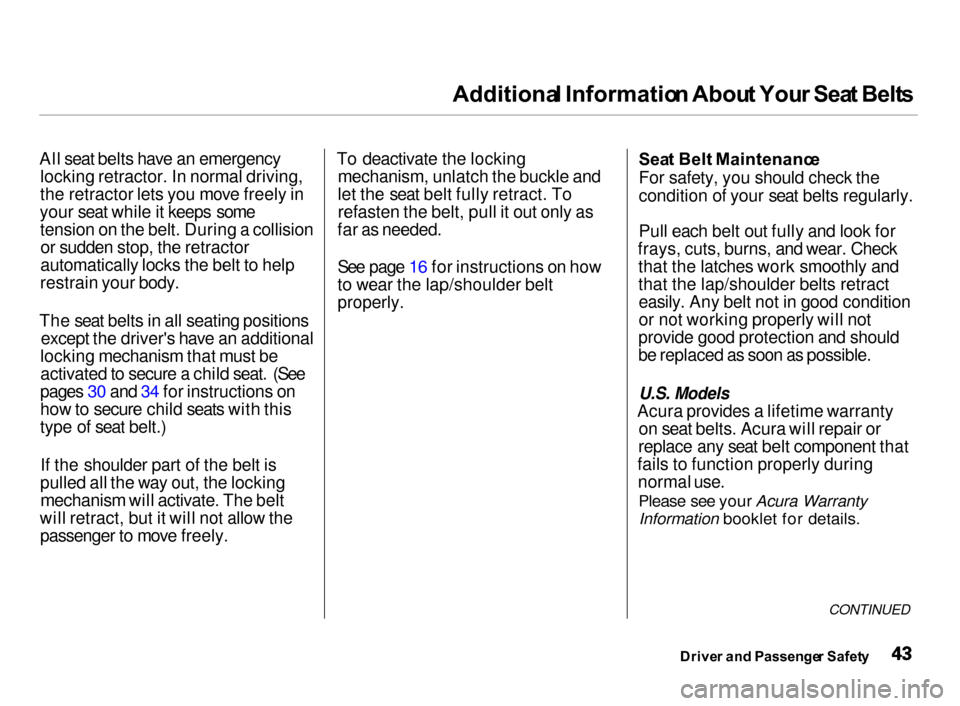
Additiona
l Informatio n Abou t You r Sea t Belt s
All seat belts have an emergency locking retractor. In normal driving,
the retractor lets you move freely in
your seat while it keeps some tension on the belt. During a collisionor sudden stop, the retractor
automatically locks the belt to help
restrain your body.
The seat belts in all seating positions except the driver's have an additional
locking mechanism that must be activated to secure a child seat. (See
pages 30 and 34 for instructions on
how to secure child seats with this
type of seat belt.)
If the shoulder part of the belt is
pulled all the way out, the locking mechanism will activate. The belt
will retract, but it will not allow the passenger to move freely. To deactivate the locking
mechanism, unlatch the buckle and
let the seat belt fully retract. To refasten the belt, pull it out only as
far as needed.
See page 16 for instructions on how
to wear the lap/shoulder belt
properly. Sea
t Belt Maintenanc e
For safety, you should check the
condition of your seat belts regularly.
Pull each belt out fully and look for
frays, cuts, burns, and wear. Check that the latches work smoothly and
that the lap/shoulder belts retracteasily. Any belt not in good condition
or not working properly will not
provide good protection and should
be replaced as soon as possible.U.S. Models
Acura provides a lifetime warranty on seat belts. Acura will repair or
replace any seat belt component that
fails to function properly during normal use.
Please see your Acura WarrantyInformation booklet for details.
CONTINUED
Drive r an d Passenge r Safet y
Page 82 of 279

Sea
t Adjustment s
Front Seat Adjustment s
See pages 13 — 14 for important safety
information and warnings about how to
properly position seats and seat-backs.
Make all seat adjustments before
you start driving.
To adjust the seat forward andbackward, pull up on the lever under
the seat cushion's front edge. Move
the seat to the desired position and
release the lever. Try to move theseat to make sure it is locked in
position.
To change the angle of the seat-back,
pull up on the lever on the outside of
the seat bottom. Move the seat-back
to the desired position and release
the lever. Let the seat-back latch in
the new position.
Instrument s an d Control s
Page 83 of 279

Sea
t Adjustment s
Driver' s Sea t Heigh t Adjustmen t
Except SE and Type-R models See pages 13 — 14 for important safety
information and warnings about how to
properly position seats and seat-backs.
Make all adjustments before youstart driving.
The height of your driver's seat is adjustable. Turn the front dial on theoutside of the seat cushion to raise
the front of the seat bottom and turn
the rear dial to raise the rear. Driver'
s Lumba r Suppor t
Vary the lumbar support by moving the lever on the right side of the
seat-back.
Instrument s an d Control s